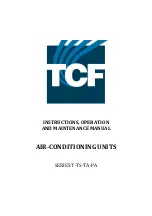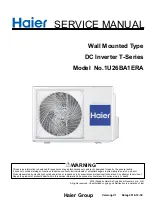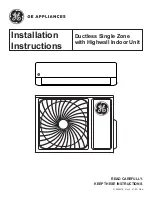
En-10
5-1. PURGING PROCEDURES AND LEAK TEST
1) Remove service port caps from stop valves on both sides of refrigerant lines.
(The stop valves are fully closed when shipped.) Leave closed.
2) Connect gauge manifold to ports of stop valves.
5-4. EXPLANATION TO THE USER
• Using the OPERATING INSTRUCTIONS, explain to the user how to use the
air conditioner (the remote controller, removing the air filters, placing or remov
-
ing the remote controller from the remote controller holder, cleaning methods,
precautions for operation, etc.)
• Recommend that the user read the OPERATING INSTRUCTIONS carefully.
Stop valve
for GAS
Stop valve cap
(Torque 15 to
22 ft-lb, 19.6 to
29.4 N•m, 200
to 300 kgf▪cm)
Vacuum pump (or the
vacuum pump with the
function to prevent the
back flow)
Gauge manifold
valve (for R410A)
Compound pressure
gauge (for R410A)
–14.7 psi [Gauge]
(–0.101 Mpa)
Handle
Low
Handle High
Adapter for
preventing the
back flow
Charge hose
(for R410A)
*Close
*Open
Hexagonal
wrench
Precautions when using the
control valve
When attaching the control valve
to the service port, valve core may
deform or loosen if excess pressure
is applied. This may cause gas leak.
Service port
Charge hose
Body
Close
Open
Control valve
A
When attaching the control valve to the
service port, make sure that the valve
core is in closed position, and then
tighten part A. Do not tighten part A
or turn the body when valve core is in
open position.
Service port cap
(Torque 10 to 13
ft -Ib, 13.7 to 17.7
N•m, 140 to 180
kgf•cm)
*4 to 5 turns
3) Evacuate the system to 4000 microns from both service valves. System
manifold gauges must not be used to measure vacuum. A micron gauge must
be used at all times. Break the vacuum with Nitrogen(N2) into the discharge
service valve to 0 PSIG.
4) Evacuate the system to 1500 microns. Break the vacuum with Nitrogen(N2)
into the discharge service valve to 0 PSIG.
5) Evacuate the system to 500 microns.
6) Close gauge manifold valves, stop the pump, and conduct a 30 minute rise
test.
7) System should hold 500 microns for a minimum of 1 hour.
8) Fully open all stop valves on both sides of gas pipe and liquid pipe. Operating
without fully opening lowers the performance and this causes trouble.
9) Refer to 1-3 and charge the prescribed amount of additional refrigerant if
needed. Be sure to charge slowly with liquid refrigerant. Otherwise composi
-
tion of the refrigerant in the system may be changed and affect performance
of the air conditioner.
10) Remove gauge manifolds and replace service port caps and tighten.
11) Leak test
Stop valve
for LIQUID
5. PURGING PROCEDURES, LEAK TEST, AND TEST RUN
Pressure gauge
(for R410A)
Caution:
• After test run or remote signal reception check, turn off the unit with the
E.O. SW or the remote controller before turning off the power supply. If this
procedure is not performed, the unit will automatically begin operation when
power supply is resumed.
To the user
• After installing the unit, explain to the user about auto restart function.
• If auto restart function is unnecessary, it can be deactivated. Consult the
service representative to deactivate the function. Refer to the service manual
for details.
5-2. TEST RUN
1) Insert power supply plug into the power outlet and/or
turn on the breaker.
2) Press the E.O. SW once for COOL, and twice for HEAT
operation. Test run will be performed for 30 minutes. If
the left lamp of the operation indicator blinks every 0.5
seconds, inspect the indoor/outdoor unit connecting
wire (A) for mis-wiring. After the test run, emergency
mode (set temperature 75°F [24°C]) will start.
3) To stop operation, press the E.O. SW several times
until all LED lamps turn off. Refer to operating instruc
-
tions for details.
Checking the remote (infrared) signal reception
Press the OFF/ON button on the remote controller (12) and listen for an
audible indicator from the indoor unit. Press the OFF/ON button again to turn
the air conditioner off.
• Once the compressor stops, the restart preventive device operates so the
compressor will not operate for 3 minutes to protect the air conditioner.
5-3. AUTO RESTART FUNCTION
This product is equipped with an auto restart function. When the power supply
is cut off during operation, such as during blackouts, the function automatically
starts operation in the previous setting once the power supply is resumed.
(Refer to the operating instructions for details.)
Emergency operation
switch (E.O. SW)
6. PUMPING DOWN
When relocating or disposing of the air conditioner, pump down the system following the procedure below so that refrigerant is not released into the atmosphere.
1) Connect the gauge manifold valve to the service port of the stop valve on the gas pipe side of the outdoor unit.
2) Fully close the stop valve on the liquid pipe side of the outdoor unit.
3) Close the stop valve on the gas pipe side of the outdoor unit almost completely so that it can be easily closed fully when the pressure gauge shows 0 psi [Gauge]
(0 Mpa).
4) Start the emergency COOL operation.
To start the emergency operation in COOL mode, disconnect the power supply plug and/or turn off the breaker. After 15 seconds, connect the power supply plug
and/or turn on the breaker, and then press the E.O. SW once. (The emergency COOL operation can be performed continuously for up to 30 minutes.)
5) Fully close the stop valve on the gas pipe side of the outdoor unit when the pressure gauge shows (0.1 to 0 psi [Gauge] (0.05 to 0 Mpa)).
6) Stop the emergency COOL operation.
To stop operation, press the E.O. SW several times until all LED lamps turn off. Refer to operating instructions for details.
WARNING
When pumping down the refrigerant, stop the compressor before dis-
connecting the refrigerant pipes. The compressor may burst if air etc.
get into it.
JG79Y071H02_en.indd 10
2016/01/21 13:20:07












































